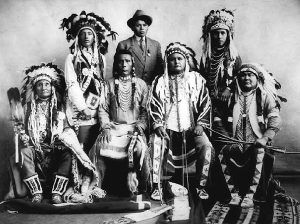Angered over broken treaties and in an attempt to repel white settlers from their lands, warriors of the Yakama and Cascade tribes attacked settlers living near the Cascades Rapids of the Columbia River on March 26, 1856. The Indians killed 14 settlers and three soldiers in the attacks. It was the costliest event in terms of white casualties during the Yakima War. However, it would ultimately be costly for the Indians as well.
The next day, on March 27, 20-40 mounted dragoons, under Lieutenant Phil Sheridan, arrived aboard the steamer Belle from Fort Vancouver. The Yakama fled, leaving the Cascade behind, who surrendered without a fight. Colonel George Wright arrived the following day and charged the prisoners with treason, even though they could not properly be charged because they were not U.S. citizens.
However, Wright immediately formed a military commission, and based on the warriors’ freshly fired rifles and their own statements, nine warriors, including Chief Chenoweth, were found guilty. Each condemned man was then positioned on a barrel, a rope placed around his neck, and the barrel kicked out from under him. Before Chief Chenoweth was executed, he gave a war-whoop and shouted, “I am not afraid to die!” As he slowly strangled, he was killed with a bullet.
Afterward, the U.S. Army established additional forts, including Fort Lugenbeel at upper Cascade Rapids and Fort Cascade on the lower rapids.
Compiled by Kathy Alexander/Legends of America, updated February 2024.
Also See:
Indian Conflicts of Washington

